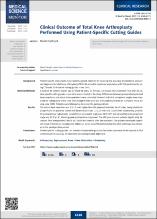| dc.contributor.author | Çalbıyık, Murat | |
| dc.date.accessioned | 2019-05-13T09:02:41Z | |
| dc.date.available | 2019-05-13T09:02:41Z | |
| dc.date.issued | 2017 | |
| dc.identifier.citation | Çalbıyık, M. (2017). Clinical outcome of total knee arthroplasty performed using patient-specific cutting guides. Medical Science Monitor, 23, 6168-6173. | en_US |
| dc.identifier.issn | 1234-1010 | |
| dc.identifier.uri | https://doi.org/10.12659/MSM.908213 | |
| dc.identifier.uri | https://hdl.handle.net/11491/1305 | |
| dc.description.abstract | Background: Patient-specific instruments have recently gained attention for ensuring the accuracy of osteotomy and correct alignment in total knee arthroplasty (TKA). We aimed to report our experience with TKA performed by using CT-based 3D model of cutting guides in our clinic. Material/Methods: A total of 36 patients (mean age, 67.58±8.46 years; 24 females, 12 males) who underwent TKA with 3D patient-specific cutting guides in our clinic were included in the study. Differences between preoperatively planned bone resections and actual bone resections were calculated. Femoral and tibial component angles were measured on radiographs of the knee. The change in knee pain was evaluated by patients on a 10-point visual analog scale (VAS). Patients were followed up for 6 months postoperatively. Results: The actual bone resection was 0.5-1.5 mm higher than the planned resection for all sides, being statistically significant for posterior lateral and distal medial sides (1.1±1.3 mm and 1.5±0.9 mm, respectively; p<0.05). On postoperative radiographs, coronal tibial component angle was 88.8°±0.9° and coronal femoral component angle was 95.2°±1.6°, showing good postoperative alignment. The VAS pain score of patients significantly decreased from preoperative 3.9±0.8 to 1.1±0.9 at 6 months after the operation. One patient developed superficial tissue infection on postoperative follow-up, which was effectively treated. No other pathology was detected in the postoperative period. Conclusions: Patient-specific cutting guides can provide intraoperative guidance for better placement of the implant in TKA and increase the accuracy of osteotomy and postoperative alignment. © Med Sci Monit. | en_US |
| dc.language.iso | eng | |
| dc.publisher | International Scientific Information, Inc. | en_US |
| dc.relation.isversionof | 10.12659/MSM.908213 | en_US |
| dc.rights | info:eu-repo/semantics/openAccess | en_US |
| dc.rights | Attribution-NonCommercial-NoDerivatives 4.0 International (CC BY-NC-ND 4.0) | * |
| dc.rights.uri | https://creativecommons.org/licenses/by-nc-nd/4.0/ | * |
| dc.subject | Arthroplasty | en_US |
| dc.subject | Replacement | en_US |
| dc.subject | Knee | en_US |
| dc.subject | Knee Dislocation | en_US |
| dc.subject | Osteotomy | en_US |
| dc.title | Clinical outcome of total knee arthroplasty performed using patient-specific cutting guides | en_US |
| dc.type | article | en_US |
| dc.relation.journal | Medical Science Monitor | en_US |
| dc.department | Hitit Üniversitesi, Tıp Fakültesi, Cerrahi Tıp Bilimleri Bölümü | en_US |
| dc.identifier.volume | 23 | en_US |
| dc.identifier.startpage | 6168 | en_US |
| dc.identifier.endpage | 6173 | en_US |
| dc.relation.publicationcategory | Makale - Uluslararası Hakemli Dergi - Kurum Öğretim Elemanı | en_US |



















